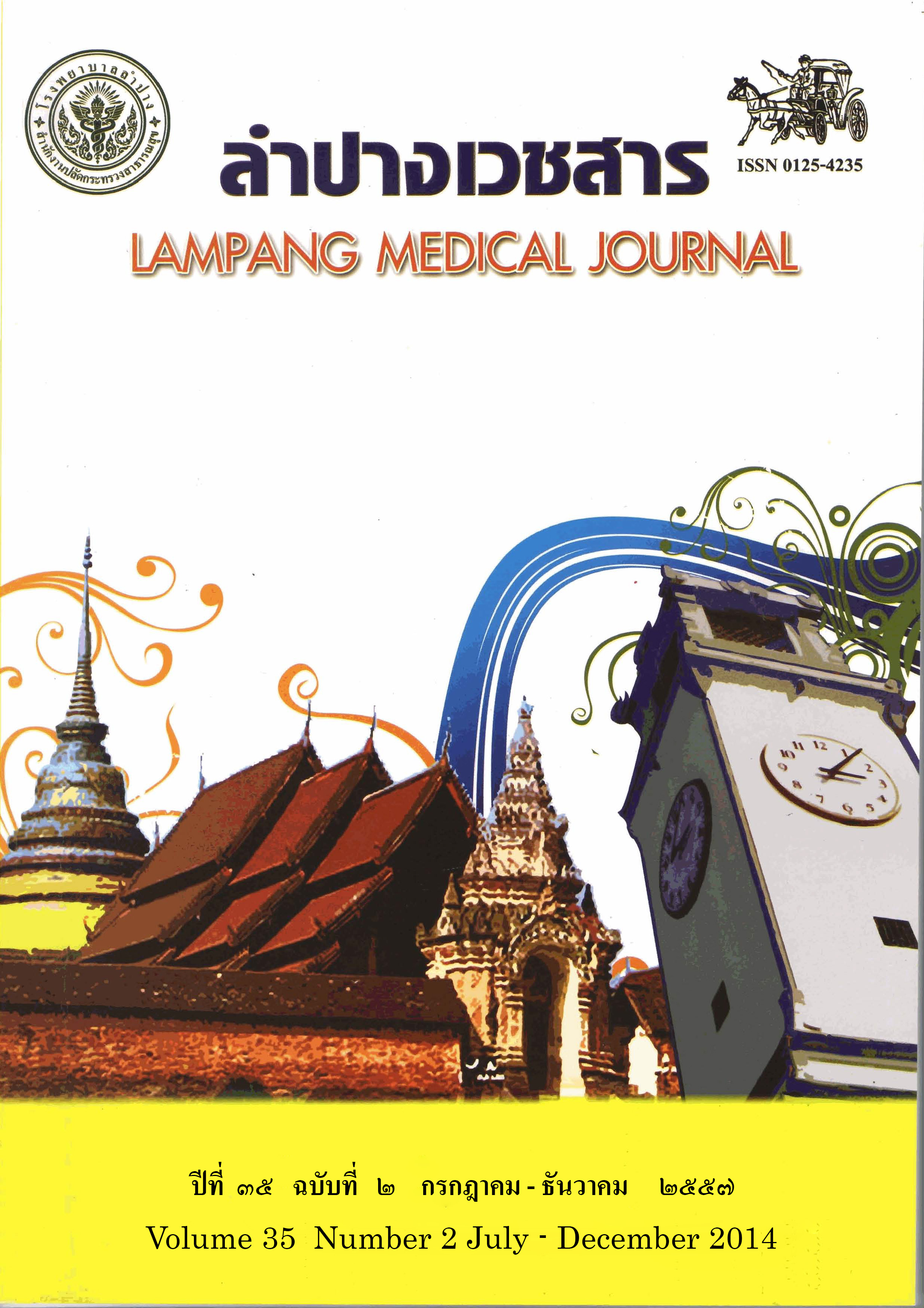Accuracy of Acetabular Cup Positioning by Using Smartphone: Comparison between Two Program Applications and Operating System
Main Article Content
Abstract
Background: Acetabular cup positioning in total hip arthroplasty is usually performed by using alignment guide for cup orientation and often difficult to assess. Smartphone technology of the iPhone and its downloaded applications were found to be accurate for improving acetabular cup placement in the optimal zone.
Objective: To compare the accuracy of acetabular cup positioning between using single application of 1 Android phone with alignment guide and dual applications of 2 iPhones without alignment guide.
Material and method: An experimental study was conducted on pelvic sawbone secured on the table in lateral decubitus position. Each surgeon (5 experienced staffs and 5 residents) placed cementless cup into the pelvis 20 times by holding an insertion rod and orientating by two methods. Firstly, handling 1 Android phone on top and parallel to the alignment guide and secondly, handling 2 iPhones on top the insertion rod and parallel to table border. The target positions were operative inclination 45o/ operative anteversion 20o (OI45o/OA20o) and OI40o/OA30o. AP digitized radiographs were taken. Radiographic inclination (RI) and radiographic anteversion (RA) were measured and calculated by using PACS program. Cup positions were analyzed, compared between each methods and between two groups of surgeons by using t-test and Mann-Whitney U test.
Results: Using Android phone with alignment guide at OI45o/OA20o target resulted less average RI than using iPhones (44.9o± 0.6o vs 45.8o± 1.1o, p<0.001) but more average RA (12.6o± 2.6o vs 11.0o± 3.1o, p=0.009). At OI40o/OA30o target, there was no difference between groups in both RI (p=0.524) and RA (p=0.526). Cups positioned by experienced staffs had more RA than by residents (13.0o± 2.8o vs 10.6o± 2.7o, p<0.001) at OI45o/OA20o target but no difference in RI (p=0.929). At OI40o/OA30o target, experienced staffs positioned cups in more RI (43.7o± 1.5o vs 42.7o± 1.4o, p=0.001) and RA (18.2o± 2.9o vs 14.3o± 3.2o, p<0.001). Reducing OI by 5° and increasing OA by 10° resulted in 2°- 3° less RI and 4°- 5° more RA.
Conclusion: Android smartphone with single application was more accurate in acetabular cup positioning than iPhones with dual applications at OI45o/OA20o target but indifferent at OI40o/OA30o target.
Article Details

This work is licensed under a Creative Commons Attribution-NonCommercial-NoDerivatives 4.0 International License.
บทความที่ส่งมาลงพิมพ์ต้องไม่เคยพิมพ์หรือกำลังได้รับการพิจารณาตีพิมพ์ในวารสารอื่น เนื้อหาในบทความต้องเป็นผลงานของผู้นิพนธ์เอง ไม่ได้ลอกเลียนหรือตัดทอนจากบทความอื่น โดยไม่ได้รับอนุญาตหรือไม่ได้อ้างอิงอย่างเหมาะสม การแก้ไขหรือให้ข้อมูลเพิ่มเติมแก่กองบรรณาธิการ จะต้องเสร็จสิ้นเป็นที่เรียบร้อยก่อนจะได้รับพิจารณาตีพิมพ์ และบทความที่ตีพิมพ์แล้วเป็นสมบัติ ของลำปางเวชสาร
References
Kennedy JG, Rogers WB, Soffe KE, Sullivan RJ, Griffen DG, Sheehan LJ. Effect of acetabular component orientation on recurrent dislocation, pelvic osteolysis, polyethylene wear, and component migration. J Arthroplasty 1998;13:530-4.
Patil S, Bergula A, Chen PC, Colwell CW Jr, D’Lima DD. Polyethylene wear and acetabular component orientation. J Bone Joint Surg Am 2003;85(Suppl 4):56-63.
Little NJ, Busch CA, Gallagher JA, Rorabeck CH, Bourne RB. Acetabular polyethylene wear and acetabular inclination and femoral offset. Clin Orthop Relat Res 2009;467(11):2895-900.
Ayasama I, Akiyoshi Y, Naito M, Ezoe M. Intraoperative pelvic motion in total hip arthroplasty. J Arthroplasty 2004;19:992-7.
Digioia III AM, Jaramaz B, Plakseychuk AY, Moody JE Jr, Nikou C, Labarca RS, et al. Comparison of a mechanical acetabular alignment guide with computer placement of the socket. J Arthroplasty 2002;17:359-64.
Minoda Y, Ohzono K, Aihara M, Umeda N, Tomita M, Hayakawa K. Are acetabular component alignment guides for total hip arthroplasty accurate?. J Arthroplasty 2010;25(6):986-9.
Lewinnek GE, Lewis JL, Tarr R, Compere CL, Zimmerman JR. Dislocations after total hip-replacement arthroplasties. J Bone Joint Surg Am 1978;60(2):217-20.
Callanan MC1, Jarrett B, Bragdon CR, Zurakowski D, Rubash HE, Freiberg AA, et al. The John Charnley Award: risk factors for cup malpositioning: quality improvement through a joint registry at a tertiary hospital. Clin Orthop Relat Res 2011;469(2):319-29.
Gandhi R, Marchie A, Farrokhyar F, Mahomed N. Computer navigation in total hip replacement: a meta-analysis. Intl Orthop (SICOT) 2009;33:593-7.
Moskal JT, Capps SG. Acetabular component positioning in total hip arthroplasty: An evidence-based analysis.
J Arthroplasty 2011;26:1432-7.
Peters FM, Greeff R, Goldstein N, Frey CT. Improving acetabular cup orientation in total hip arthroplasty by using smartphone technology. J Arthroplasty 2012;27(7):1324-30.
Hassan DM, Johnston GH, Dust WN, Watson G, Dolovich AT. Accuracy of intraoperative assessment of acetabular prosthesis placement. J Arthroplasty 1998;13(1):80-4.
Murray DW. The definition and measurement of acetabular orientation. J Bone Joint Surg Br 1993;75(2):228-32.
Jolles BM, Genoud P, Hoffmeyer P. Computer-assisted cup placement techniques in total hip arthroplasty improve accuracy of placement. Clin Orthop Relat Res 2004;426:174-9.
Honl M, Schwieger K, Salineros M, Jacobs J, Morlock M, Wimmer M. Orientation of the acetabular component. A comparison of five navigation systems with conventional surgical technique. J Bone Joint Surg Br 2006;88(10):1401-5.


